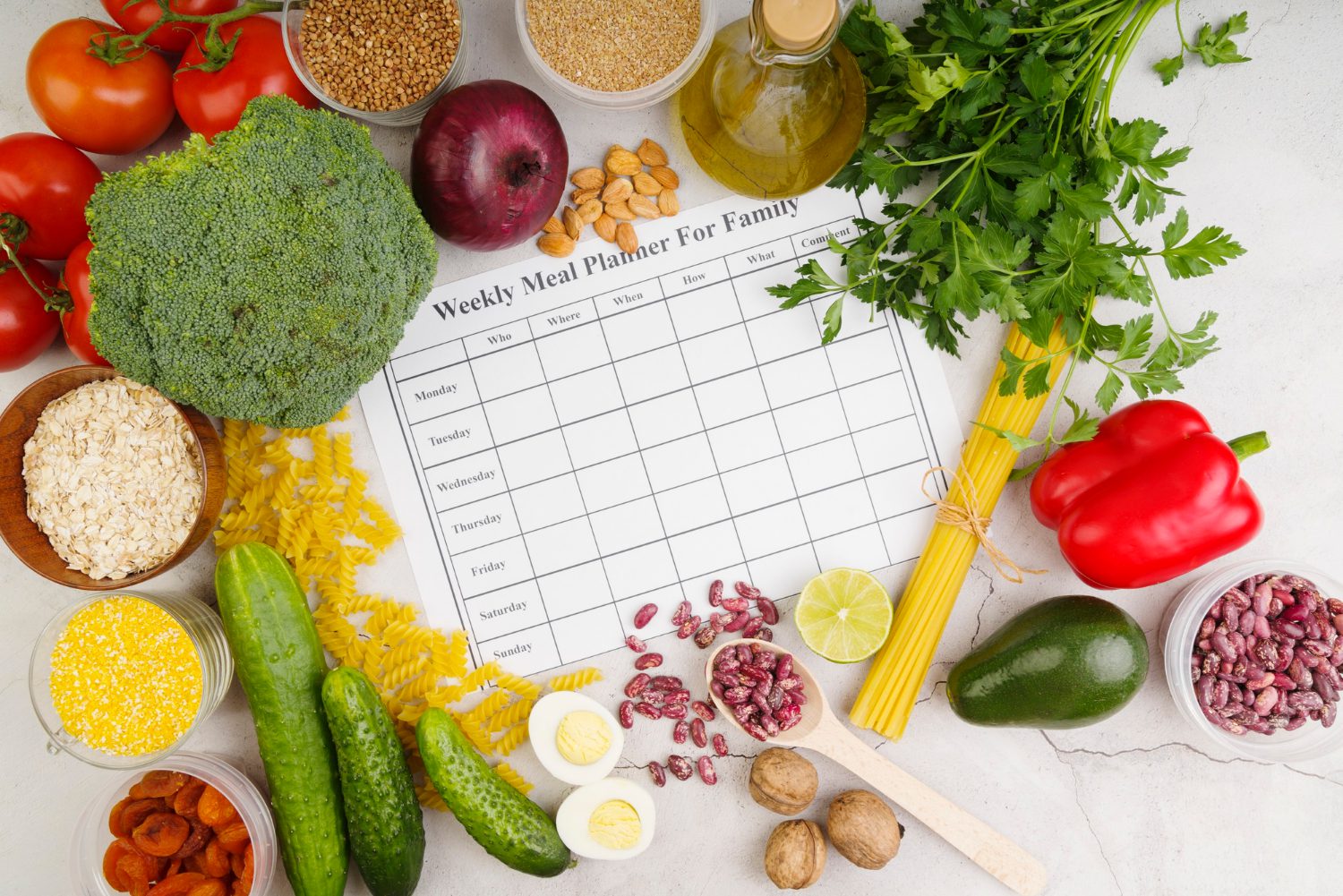
The Ultimate 30 Day Raw Food Diet Plan To Revitalize Your Health !
admin
- 0
- 7
The 30 day raw food diet plan is a strict eating regimen that involves consuming only uncooked, plant-based foods for 30 consecutive days. This diet aims to promote weight loss, increase energy levels, improve digestion, and support overall health and well-being.
By excluding processed and cooked foods, participants of this diet plan rely heavily on fruits, vegetables, nuts, seeds, and sprouted grains to meet their nutritional needs. Advocates claim that this diet can lead to various health benefits, including improved digestion, increased nutrient absorption, reduced inflammation, and enhanced detoxification.
However, it is essential to consult with a healthcare professional before embarking on any significant dietary changes, especially for individuals with preexisting health conditions or nutrient deficiencies.

Table of Contents
ToggleBenefits Of A Raw Food Diet Plan
Experience the numerous benefits of a 30-day raw food diet plan, including improved digestion, increased energy levels, weight loss, and enhanced overall health and well-being. Discover the power of nourishing your body with natural, unprocessed foods for optimal vitality and vitality.
Overview Of The Health Benefits
Whether you’re on a mission to improve your health or simply want to try something new, a raw food diet plan can offer a wide range of benefits. This eating regimen focuses on consuming unprocessed, plant-based foods in their natural state, without cooking.
By following a raw food diet plan for 30 days, you can experience an array of health perks that will leave you feeling energized and refreshed. Here are some of the key benefits you can expect:
Increased Energy And Vitality
- Raw foods are rich in enzymes that help with digestion, allowing your body to efficiently break down and utilize nutrients. This can result in a natural boost of energy and improved vitality.
- The high fiber content in raw foods aids in stabilizing blood sugar levels, preventing energy crashes and providing sustained energy throughout the day.
- Consuming raw fruits and vegetables can help reduce the consumption of processed foods that are often laden with added sugars and unhealthy fats, further contributing to increased energy levels.
Improved Digestion And Nutrient Absorption
- Raw foods retain their natural enzymes, which play a crucial role in the digestion process. These enzymes can help ease digestive issues such as bloating, gas, and constipation.
- The abundance of fiber in raw foods promotes regular bowel movements and supports a healthy gut. This, in turn, aids nutrient absorption and prevents the accumulation of toxins in the body.
- Unlike cooked foods, raw foods maintain their high nutrient content, ensuring that you receive an optimal amount of vitamins, minerals, and antioxidants for overall health and vitality.
Weight Loss And Maintenance
- Following a 30-day raw food diet plan can kickstart your weight loss journey. Raw foods are generally low in calories and high in fiber, helping you feel satisfied and full while reducing overall calorie intake.
- The high water content in raw fruits and vegetables contributes to increased satiety and hydration, further supporting weight loss efforts.
- Raw foods also tend to have a lower glycemic index, which means they are less likely to cause spikes in blood sugar levels. This can help stabilize appetite and reduce cravings for unhealthy, calorie-dense foods.
Enhanced Skin Health And Appearance
- Raw foods, particularly those rich in antioxidants and vitamins, can promote radiant skin and a youthful appearance. These nutrients help protect the skin against free radical damage, resulting in healthier, clearer skin.
- The high water content in raw fruits and vegetables helps hydrate the skin, leaving it plump and moisturized. This can reduce the appearance of fine lines and wrinkles.
- A raw food diet plan often eliminates processed foods that can contribute to skin issues such as acne and inflammation. By focusing on nutrient-dense, whole foods, you can achieve a brighter complexion and improved skin tone.
Embarking on a 30-day raw food diet plan can offer a myriad of benefits for your overall health and well-being. From increased energy and vitality to improved digestion, weight loss, and enhanced skin health, this lifestyle choice can bring about positive changes that leave you feeling amazing both inside and out.
So why not give it a try and experience the transformative power of raw foods?
Getting Started With The 30 Day Raw Food Diet Plan
Discover how to kick-start your journey towards a healthier lifestyle with the 30 day raw food diet plan. This comprehensive plan provides you with all the tools and resources you need to embrace a raw food diet and reap the countless benefits it offers.
Are you ready to embark on a transformative journey with a 30 day raw food diet plan? This comprehensive guide will provide you with all the necessary information to kickstart your raw food journey and achieve optimal health. From setting clear goals and understanding the principles of a raw food diet to stocking up on essentials and meal planning, we’ve got you covered.
Let’s delve into the first step of getting started!
Setting Clear Goals And Objectives:
To ensure success on your 30 day raw food diet plan, it’s important to set clear goals and objectives. Here are some key points to consider:
- Determine your motivation: Identify why you want to follow a raw food diet. Whether it’s to improve your overall wellbeing, shed a few pounds, or boost your energy levels, having a clear purpose will keep you focused.
- Set realistic expectations: Rome wasn’t built in a day, and neither will your raw food journey be. Establish achievable goals and be patient with yourself during the transition process. Gradually incorporating raw foods into your diet is a sustainable approach.
- Track your progress: Keep a journal to record your daily experiences, challenges, and achievements. This will help you stay accountable and provide insight into how the diet is affecting your body and mind.
Understanding The Principles Of A Raw Food Diet:
Before diving headfirst into the 30 day raw food diet plan, it’s crucial to grasp the principles that underpin this lifestyle. Here’s what you need to know:
- Raw food basics: A raw food diet primarily consists of consuming uncooked, unprocessed, and predominantly plant-based foods. The main idea is to preserve the nutrients and enzymes in the food by avoiding cooking methods that can deplete them.
- Focus on fresh produce: Incorporate a wide variety of fruits, vegetables, nuts, and seeds into your daily meals. These nutrient-dense foods will provide you with essential vitamins, minerals, and antioxidants.
- Hydration is key: Stay hydrated by drinking plenty of water and incorporating hydrating fruits and vegetables, such as cucumbers and watermelons, into your diet.
Stocking Up On Raw Food Essentials:
Having the right ingredients on hand is essential for a successful 30 day raw food diet plan. Here are some must-haves for your pantry and fridge:
- Fresh fruits and vegetables: Opt for organic produce whenever possible to minimize exposure to pesticides and ensure superior taste and nutritional value.
- Nuts and seeds: Almonds, walnuts, chia seeds, and flaxseeds are excellent sources of healthy fats, protein, and fiber. They can be used in various recipes or enjoyed as snacks.
- Superfoods: Boost your nutrient intake by incorporating superfoods like spirulina, cacao nibs, and goji berries into your diet. These powerhouse ingredients offer a wide range of health benefits.
Meal Planning And Preparation Tips:
Efficient meal planning and preparation are key to staying on track during your 30 day raw food diet plan. Consider the following tips:
- Plan your meals in advance: Schedule your meals and snacks for the week, ensuring you have a balance of nutrients and variety in your diet.
- Prepare and store in advance: Wash, chop, and store your fruits and vegetables in containers, so they’re ready to grab when hunger strikes. This will save you time and make healthy choices more convenient.
- Experiment with recipes: Raw food doesn’t mean boring food! Explore creative recipes that incorporate different flavor profiles and textures to keep your taste buds excited.

Creating A Supportive Environment:
The journey towards a healthier you is easier with a supportive environment. Consider these tips to create a space conducive to your raw food diet:
- Share your goals: Communicate your intentions with friends and family, asking for their support and understanding during your 30 day raw food diet plan.
- Join communities: Connect with like-minded individuals on social media or local raw food groups to exchange ideas, get advice, and celebrate milestones together.
- Surround yourself with healthy options: Remove processed and unhealthy foods from your home and replace them with vibrant fruits, vegetables, and raw food snacks. This will make it easier to resist temptation.
Now that you have a solid foundation for getting started with the 30 day raw food diet plan, it’s time to embark on your exciting journey towards vibrant health and wellbeing. Remember to stay consistent, listen to your body, and enjoy the benefits of nourishing yourself with nature’s bounty.
Creating Delicious And Nutritious Raw Food Meals
Discover the secrets of a 30-day raw food diet plan that will help you create delicious and nutritious meals. Boost your health and vitality with these raw food recipes packed with essential nutrients and flavors.
Eating a raw food diet can be a flavorful and nourishing experience when you focus on creating delicious meals that satisfy your taste buds and provide essential nutrients for your body. Incorporating a variety of fruits and vegetables, exploring different food preparation techniques, enjoying raw food snacks and desserts, and ensuring a balanced macronutrient intake are all important aspects to consider.
Additionally, staying hydrated through the consumption of raw juices plays a vital role in supporting your overall health and wellness.
Incorporating A Variety Of Fruits And Vegetables:
- Include a wide range of colorful fruits and vegetables in your raw food diet.
- Experiment with seasonal produce to add variety and freshness to your meals.
- Aim for a mix of leafy greens, cruciferous vegetables, fruits, and root vegetables to ensure a diverse nutrient intake.
- Try incorporating exotic fruits and vegetables to enhance the flavor and excitement of your raw meals.
Exploring Different Food Preparation Techniques:
- Experiment with various techniques such as juicing, blending, dehydrating, and sprouting.
- Utilize a spiralizer to create vegetable noodles for a satisfying raw pasta dish.
- Try marinating vegetables to add depth of flavor and enhance texture.
- Explore fermenting vegetables to promote gut health and introduce beneficial probiotics into your diet.
Raw Food Snacks And Desserts:
- Prepare dehydrated fruit chips for a nutritious and tasty on-the-go snack.
- Create energy balls using dates, nuts, and seeds for a satisfying and nourishing treat.
- Make refreshing raw fruit sorbets by blending frozen fruits with a splash of coconut water.
- Experiment with raw cacao to create decadent and guilt-free desserts like raw chocolate mousse or brownies.
Ensuring Balanced Macronutrient Intake:
- Incorporate a variety of plant-based proteins such as nuts, seeds, and legumes into your meals.
- Include healthy fats from sources like avocados, coconut, and cold-pressed oils.
- Opt for complex carbohydrates from vegetables, fruits, and sprouted grains.
- Balancing your macronutrient intake will help provide energy and support overall health.
Hydration And The Role Of Raw Juices:
- Drink raw juices made from fresh fruits and vegetables to stay hydrated.
- Raw juices are a great way to introduce additional nutrients and enzymes into your diet.
- Include hydrating ingredients like cucumber and watermelon in your juice recipes.
- Be mindful of sugar content and try to opt for lower sugar fruits when juicing.
Creating delicious and nutritious raw food meals is all about experimenting with different ingredients, techniques, and flavors. By incorporating a variety of fruits and vegetables, exploring various food preparation methods, enjoying raw snacks and desserts, and ensuring a balanced macronutrient intake, you can create a raw food diet that is enjoyable, satisfying, and beneficial for your overall well-being.
Stay hydrated through the consumption of raw juices, and remember that the possibilities are endless when it comes to creating delicious and nourishing raw food meals.
Overcoming Challenges And Staying Motivated
Embarking on a 30-day raw food diet plan can be challenging, but with determination and motivation, it’s possible to overcome obstacles and stay on track. By focusing on the health benefits and adopting a positive mindset, individuals can successfully complete the plan and achieve their desired results.
Dealing with cravings and temptations:
- Stay hydrated: Drink plenty of water throughout the day to help curb cravings and keep your body nourished.
- Stock up on healthy snacks: Keep a variety of fruits, vegetables, and nuts on hand to satisfy your cravings for something crunchy or sweet.
- Replace unhealthy options: Find raw food substitutes for your favorite comfort foods, such as raw vegan desserts or zucchini noodles instead of pasta.
- Practice mindful eating: Pay close attention to your body’s hunger and fullness cues to prevent mindless snacking.
- Find healthy distractions: Engage in activities like exercise, reading, or spending time in nature to redirect your focus away from food cravings.
Strategies for dining out on a raw food diet:
- Research the menu beforehand: Look for raw food-friendly restaurants or find out if the restaurant offers any raw options.
- Customize your order: Don’t be afraid to ask for modifications to accommodate your raw food diet, such as opting for a salad or requesting a plate of raw vegetables.
- Bring your own snacks: If you’re unsure about the available options, pack some raw food snacks to enjoy during your outing.
- Communicate with the waiter: Explain your dietary preferences and ask for guidance in selecting raw food options.
- Enjoy the social aspect: Focus on enjoying the company of friends or family instead of solely focusing on the food.
Managing social situations and gatherings:
- Communicate with loved ones: Let friends and family know about your raw food journey, so they can be supportive and understanding of your choices.
- Offer to bring a dish: Bring a raw food dish to share at gatherings, ensuring there’s something delicious and nutritious for you to enjoy.
- Seek out like-minded individuals: Connect with others who follow a raw food diet through online communities or local meetups for support and sharing of experiences.
- Focus on the company: Shift your attention towards socializing and bonding with others, rather than fixating on the food being served.
- Plan ahead: If attending events where raw options might be limited, have a small raw meal or snack beforehand to prevent feeling deprived.
Handling emotional triggers and stress:
- Practice self-care: Engage in activities that help reduce stress, such as meditation, deep breathing exercises, or yoga.
- Find healthy coping mechanisms: Instead of turning to food for comfort, explore alternative ways to deal with emotions, such as journaling, talking to a friend, or going for a walk.
- Seek professional support: If emotional triggers and stress become overwhelming, consider working with a therapist or counselor to develop healthy coping strategies.
- Build a support network: Surround yourself with individuals who understand and support your raw food journey, and can provide encouragement during challenging times.
- Be kind to yourself: Remember that it’s normal to face emotional ups and downs along the way. Practice self-compassion and embrace the learning process.
Finding support and accountability partners:
- Attend raw food workshops and events: Join workshops or seminars related to raw food, where you can meet individuals who share similar health goals.
- Join online communities: Participate in forums, facebook groups, or instagram communities dedicated to raw food enthusiasts to connect with others and seek support.
- Buddy up: Find a raw food buddy who can join you on this journey. Share recipes, meal plans, and experiences to stay motivated together.
- Share progress: Celebrate your achievements and milestones with your support network. Sharing your progress can inspire others and keep you motivated as well.
- Consider a raw food coach: If you’re looking for more personalized support, working with a raw food coach can provide guidance, motivation, and accountability throughout your 30-day plan.
Remember, staying motivated on a 30-day raw food diet plan requires dedication, but the benefits to your health and well-being are worth it. Embrace the challenges, overcome them with these strategies, and enjoy the journey towards vibrant, raw food living.
Tracking Your Progress And Making Adjustments
Tracking your progress and making adjustments is essential for successfully following a 30-day raw food diet plan. By regularly evaluating your results and making necessary changes, you can ensure optimal health and achieve your desired goals.
Embarking on a 30-day raw food diet plan requires dedication and attention to detail. By tracking your progress and making adjustments along the way, you can ensure that you are getting the most out of this experience. Here are a few key areas to focus on:
Keeping A Food And Mood Diary:
- Maintain a daily journal documenting all the foods you consume during the raw food diet. This will help you analyze your eating habits and identify any patterns.
- Note down your mood and emotions throughout the day, as your diet can have an impact on your mental well-being. This will help you understand the correlation between your food choices and how you feel.
Monitoring Weight Loss And Body Measurements:
- Regularly weigh yourself and track your progress. Keep in mind that weight loss might vary from person to person, so focus on the overall trend rather than day-to-day fluctuations.
- Take measurements of your body, such as waist, hips, and thighs, to track changes in your body composition. This will give you a more accurate picture of your progress and help you stay motivated.
Evaluating Energy Levels And Overall Well-Being:
- Pay attention to your energy levels throughout the day. Note any significant changes and how they correlate with your diet.
- Assess your overall well-being, including factors such as sleep quality, digestion, and skin health. These indicators can provide insight into how your body is responding to the raw food diet.
Adjusting Meal Plans Based On Individual Needs:
- As you progress through the 30-day raw food diet plan, you may find that certain foods work better for you than others. Adjust your meal plans accordingly by removing or adding foods that suit your preferences and digestion.
- Experiment with different recipes and ingredients to keep your meals exciting and satisfying. Listen to your body and adapt your diet to ensure it meets your nutritional needs.
Consulting With A Healthcare Professional Or Nutritionist:
- It is always advisable to seek professional guidance when making significant dietary changes. Consulting with a healthcare professional or nutritionist can provide personalized advice and ensure that you are on the right track.
- They can help address any concerns, provide recommendations for supplements if necessary, and fine-tune your diet plan according to your individual needs.
Remember, the key to success with a 30-day raw food diet plan lies in tracking your progress, making adjustments when needed, and seeking guidance from professionals. By doing so, you can make the most of this experience and achieve your health and wellness goals.
Good luck on your journey!
Maintaining A Raw Food Lifestyle Beyond 30 Days
Maintain a raw food lifestyle beyond 30 days with our comprehensive 30-day raw food diet plan. Enjoy the benefits of increased energy, improved digestion, and a healthier body by incorporating fresh, unprocessed foods into your daily routine. Start your journey to vibrant health today!
Transitioning to a raw food diet for 30 days can bring about significant health benefits, increased energy levels, and a renewed sense of well-being. However, it’s essential to have a plan in place to maintain this lifestyle in the long run.
Here are some strategies to help you sustain the benefits of a raw food diet beyond the initial 30 days:
Integrating Cooked Foods Back Into The Diet:
- Gradually reintroduce cooked foods: Begin by incorporating lightly steamed vegetables or baked sweet potatoes into your meals. This gradual approach will allow your body to adjust to the cooked foods while still retaining the benefits of raw foods.
- Emphasize whole, unprocessed cooked foods: Opt for whole grains, legumes, and lean proteins as your cooked food choices. Avoid highly processed and fried foods, as they can diminish the positive effects of a raw food diet.
- Stay mindful of portion sizes: Be conscious of the amount of cooked foods you consume, as they can be more calorie-dense than raw foods. Maintain a balanced approach to ensure you’re still getting a significant portion of your nutrition from raw fruits and vegetables.
Sustaining Long-Term Health Benefits:
- Monitor your nutrient intake: While raw foods are highly nutritious, it’s crucial to ensure that you’re getting a wide range of nutrients. Consider incorporating a variety of fruits, vegetables, nuts, seeds, and sprouts into your meals to maintain a well-rounded nutrient intake.
- Stay hydrated: Hydration is key to overall health, and it becomes even more critical when following a raw food diet. Drink an adequate amount of water throughout the day to stay hydrated and support optimal bodily functions.
- Prioritize sleep and stress management: Good sleep and stress management are integral components of long-term health. Aim for quality sleep and incorporate stress-reduction techniques such as meditation or yoga into your routine.
Ensuring A Balanced And Diverse Nutrient Intake:
- Include a variety of fruits and vegetables: Aim to eat a rainbow of produce to ensure you’re obtaining a wide range of vitamins, minerals, and phytonutrients.
- Incorporate plant-based protein sources: Beans, lentils, quinoa, hemp seeds, and chia seeds can provide essential amino acids to support muscle maintenance and overall health.
- Don’t forget healthy fats: Include avocados, nuts, seeds, and cold-pressed oils in your meals to ensure an adequate intake of healthy fats, which play a crucial role in brain health and hormone production.
Gradually Transitioning To A Flexible Raw Food Diet:
- Explore raw food recipes and options: Look for creative ways to enjoy raw foods by exploring recipes and experimenting with different ingredients. This can help you maintain variety in your meals and prevent monotony.
- Practice mindful eating: Listen to your body and pay attention to its needs. If you feel the desire for a cooked meal occasionally, honor that and make conscious choices that align with your overall health goals.
- Seek support and guidance: Join online communities, forums, or local raw food groups to connect with others on a similar journey. Sharing experiences, tips, and recipes can provide valuable support and inspiration.
Creating A Sustainable Wellness Routine:
- Make physical activity a priority: Engaging in regular exercise is crucial for maintaining overall health and complementing your raw food lifestyle. Find activities you enjoy, such as walking, yoga, or dancing, and incorporate them into your daily routine.
- Continuously educate yourself: Stay informed about nutrition, wellness, and the raw food lifestyle to deepen your understanding and motivation. Read books, follow reputable blogs, and listen to podcasts to expand your knowledge.
- Embrace adaptability: Remember that a raw food lifestyle doesn’t have to be rigid. Allow yourself flexibility in certain situations, such as dining out or attending social events. Strive for a balanced and practical approach that fits your individual needs and circumstances.
Maintaining a raw food lifestyle beyond the initial 30 days requires mindful choices, gradual integration of cooked foods, and a focus on overall well-being. By following these strategies, you can continue to enjoy the numerous health benefits and vitality that a raw food diet offers.
Frequently Asked Questions On 30 Day Raw Food Diet Plan
What Is A Raw Food Diet Plan?
A raw food diet plan emphasizes the consumption of uncooked and unprocessed foods, such as fruits, vegetables, nuts, and seeds. It aims to preserve the nutrients in food and provide numerous health benefits.
Can A Raw Food Diet Help With Weight Loss?
Yes, a well-structured raw food diet plan can aid in weight loss. The high fiber content and low-calorie nature of raw foods help control appetite, reduce calorie intake, and promote a healthy weight.
What Are The Potential Benefits Of A Raw Food Diet?
A raw food diet plan can improve digestion, increase energy levels, enhance skin health, support weight loss, lower the risk of chronic diseases, and promote overall well-being.
Is It Possible To Get All Necessary Nutrients On A Raw Food Diet?
Yes, by properly planning a raw food diet to include a variety of fruits, vegetables, nuts, seeds, and sprouts, it is possible to obtain all necessary nutrients, including proteins, healthy fats, vitamins, minerals, and antioxidants.
Are There Any Risks Or Potential Drawbacks Of A Raw Food Diet?
While a raw food diet can be beneficial, some potential risks include nutrient deficiencies, foodborne illnesses, challenges in meeting calorie requirements, and difficulties in social situations. It’s important to consult a healthcare professional before starting any new diet plan.
Can I Follow A Raw Food Diet If I Have Certain Dietary Restrictions?
Yes, a raw food diet can be modified to accommodate dietary restrictions such as gluten-free, dairy-free, or vegan. With careful planning and creative recipes, you can still enjoy a variety of delicious and nutritious meals while adhering to your restrictions.
Conclusion
The 30-day raw food diet plan offers incredible health benefits and a rejuvenating experience. By focusing on consuming whole, unprocessed foods in their natural state, you nourish your body with essential nutrients, enzymes, and antioxidants. This approach can aid in weight loss, improve digestion, boost energy levels, and enhance overall well-being.
Throughout the journey, you may face challenges and cravings, but staying committed and motivated will ensure the best results. Remember to listen to your body’s signals and adjust the plan accordingly. Incorporating a variety of fruits, vegetables, nuts, and seeds will provide a diverse range of nutrients to support your body’s needs.
After completing the 30-day raw food diet, it is crucial to maintain a balanced and healthy eating routine, incorporating both raw and cooked foods as part of a sustainable lifestyle. Embrace the benefits and newfound vitality this diet offers and continue to prioritize your health in the long term.



